A River Bend Community Set To Music: Gees Bend Jazz Symphony
Artists are making sweet music using history and museum collections as inspiration
/https://tf-cmsv2-smithsonianmag-media.s3.amazonaws.com/filer/GeeBend_quilting_bee-thumb.jpg)
![]()
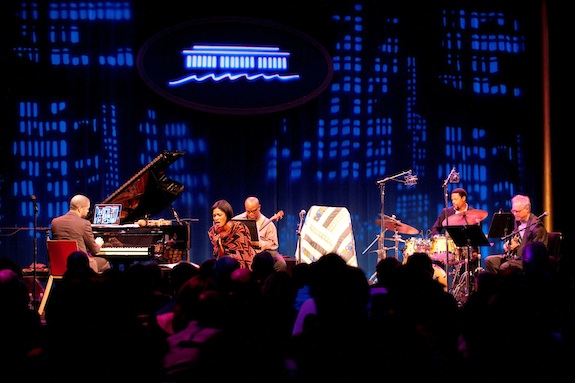
Jason Moran, Alicia Hall Moran, The Bandwagon and Bill Frisell in the KC Jazz Club October 26, 2012. Photo by Scott Suchman
A museum exhibition can showcase a collection. But music gives it soul, emotionally connecting the public to the spirit and rhythms of people and unknown stories behind objects. The Smithsonian National Museum of American History is among a vanguard of museums who have used live music performances and commissions for decades to interpret and showcase American history and collections.
The Chamber Music Society performs on the Smithsonian’s quartet of rare Stradivarius instruments bringing cultural and artistic context to classical music scholarship. The Smithsonian Jazz Masterworks Orchestra (SJMO) enriches jazz collections with live performances of unpublished music from the collections and appearances by jazz masters representing living history. The Rubin Museum of Art in New York City—a Smithsonian Affiliate—has musicians of diverse genres interpret art on exhibition and musically engage the public in themes inherent in Himalayan art and culture.
Other museums are catching onto the music-collections connections.
In 2008, Moran, artistic adviser for jazz at the Kennedy Center, was commissioned by The Philadelphia Art Museum to compose music for a Gees Bends Quilts exhibition. The result was a jazz symphony that melded rhythms from the community’s past with improvisational jazz felt in the moment. When the quilts and the stories were put away, the music remained in their stead. Recently, Moran staged his Gees Bend jazz at the Kennedy Center. During this Black History Month, jazz vocalist Dee Dee Bridgewater is taking the music and the Gees Bend story to the nation via the first national broadcast of the composition, offered over NPR’s JazzSet.
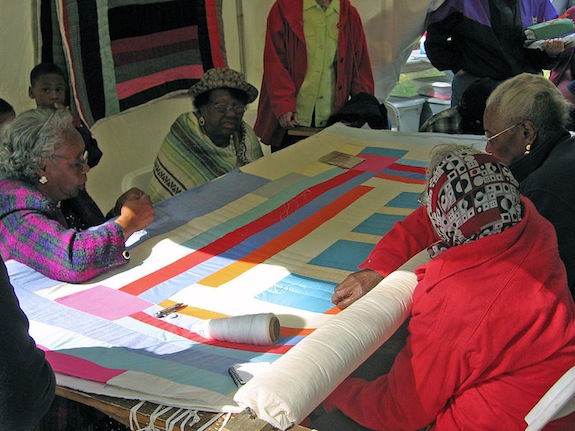
Women from Gee’s Bend work on a quilt during the 2005 ONB Magic City Art Connection in Birmingham, Alabama’s Linn Park. Photo by Andre Natta, courtesy of Wikimedia
To develop the piece, Moran, his wife Alicia, an accomplished opera singer, and members of his band traveled to Gees Bend to conduct research and embrace the people of the remote community. Their improvisational conversation is recorded in musical masterpieces ranging from Alica’s rendition of the Quilter’s Song, first recorded in the field in 1941 for the compilation How We Got Over: Sacred Songs of Gees Bend, to the band’s musical interpretation of a quilt pattern. The Morans have created similar music commissions to help museum’s present history and collections. A case in point is Bleed, created for the Whitney Museum of Art.
Baltimore photographer Linda Day Clark has traveled to Gees Bend annually since 2002 after discovering the community on assignment for The New York Times. In a podcast for the Philadelphia quilt exhibition, she discusses the “amazing microcosm of culture” in Gees Bend, calling it both “a blessing and a curse” for its historic authenticity.
Day related a conversation she’d had with Gees Bend elder Arlonza Pettway, a descendant of slaves. Pettway told Day about sitting on her great grandmother’s quilt to hear the stories of her great grandmother’s capture in Africa, being held captive with other slaves, lured onto a ship, and their experiences during the Middle Passage.
“We’re looking at a group of Africans brought over during slavery,” says Day, ”and when slavery ended, they stayed. Very few people in Gees Bend have moved in or out.”
Located in a bend of the Alabama River, with one road leading into and out of the community, Gees Bend was founded by a North Carolina cotton grower, Joseph Gee, and 18 slaves who relocated with him to the region to farm cotton. The Gee family later sold the plantation to a relative, Mark H. Pettway.
During this 150th Anniversary of the Emancipation Proclamation and the 50th Anniversary of the March on Washington, the Smithsonian is presenting the exhibition Changing America to commemorate African Americans’ quest for freedom and equity in America. It may be argued that little has changed in Gees Bend in 150 years. Yet the stories this community has preserved and the artwork it creates continues to inspire and inform a rapidly changing world outside its reach. And with artists’ like Moran history is becoming music to their ears.
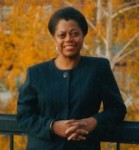
Joann Stevens of the American History Museum.
Joann Stevens is program manager of Jazz Appreciation Month (JAM), an initiative to advance appreciation and recognition of jazz as America’s original music, a global cultural treasure. JAM is celebrated in every state in the U.S. and the District of Columbia and some 40 countries every April. Recent posts include Take 5! Where Old Jazz Heads Meet Jazz Novices Over Sweet Notes and Wynton Marsalis, Honoring Duke Ellington.
Some stories and museum collections can’t be presented with words alone. For them you need music. Maybe even art. Or photography. During Black History Month 2013, the history of the community of Gees Bend, Alabama, and the spirit of the women of the Gees Bend Quilts, is being brought to the nation by jazz pianist Jason Moran, using music to help animate history and interpret museum collections.
A museum exhibition can showcase a collection. But music gives it soul, emotionally connecting the public to the spirit and rhythms of people and unknown stories behind objects. The Smithsonian National Museum of American History is among a vanguard of museums who have used live music performances and commissions for decades to interpret and showcase American history and collections.
The Chamber Music Society performs on the Smithsonian’s quartet of rare Stradivarius instruments bringing cultural and artistic context to classical music scholarship. The Smithsonian Jazz Masterworks Orchestra (SJMO) enriches jazz collections with live performances of unpublished music from the collections and appearances by jazz masters representing living history. The Rubin Museum of Art in New York City—a Smithsonian Affiliate—has musicians of diverse genres interpret art on exhibition and musically engage the public in themes inherent in Himalayan art and culture.
Other museums are catching onto the music-collections connections.
In 2008, Moran, artistic adviser for jazz at the Kennedy Center, was commissioned by The Philadelphia Art Museum to compose music for a Gees Bends Quilts exhibition. The result was a jazz symphony that melded rhythms from the community’s past with improvisational jazz felt in the moment. When the quilts and the stories were put away, the music remained in their stead. Recently, Moran staged his Gees Bend jazz at the Kennedy Center. During this Black History Month, jazz vocalist Dee Dee Bridgewater is taking the music and the Gees Bend story to the nation via the first national broadcast of the composition, offered over NPR’s JazzSet.
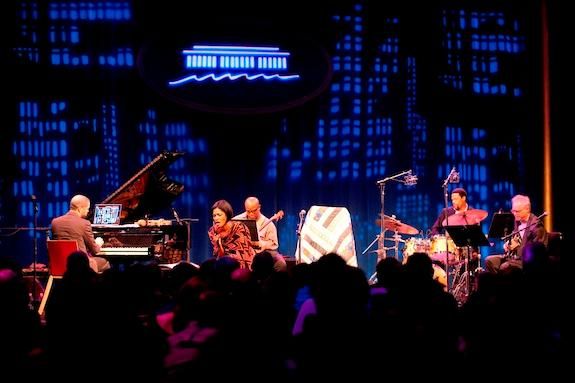
To develop the piece, Moran, his wife Alicia, an accomplished opera singer, and members of his band traveled to Gees Bend to conduct research and embrace the people of the remote community. Their improvisational conversation is recorded in musical masterpieces ranging from Alica’s rendition of the Quilter’s Song, first recorded in the field in 1941 for the compilation How We Got Over: Sacred Songs of Gees Bend, to the band’s musical interpretation of a quilt pattern. The Morans have created similar music commissions to help museum’s present history and collections. A case in point is Bleed, created for the Whitney Museum of Art.
Baltimore photographer Linda Day Clark has traveled to Gees Bend annually since 2002 after discovering the community on assignment for The New York Times. In a podcast for the Philadelphia quilt exhibition, she discusses the “amazing microcosm of culture” in Gees Bend, calling it both “a blessing and a curse” for its historic authenticity.
Day related a conversation she’d had with Gees Bend elder Arlonza Pettway, a descendant of slaves. Pettway told Day about sitting on her great grandmother’s quilt to hear the stories of her great grandmother’s capture in Africa, being held captive with other slaves, lured onto a ship, and their experiences during the Middle Passage.
“We’re looking at a group of Africans brought over during slavery,” says Day, ”and when slavery ended, they stayed. Very few people in Gees Bend have moved in or out.”
Located in a bend of the Alabama River, with one road leading into and out of the community, Gees Bend was founded by a North Carolina cotton grower, Joseph Gee, and 18 slaves who relocated with him to the region to farm cotton. The Gee family later sold the plantation to a relative, Mark H. Pettway.
During this 150th Anniversary of the Emancipation Proclamation and the 50th Anniversary of the March on Washington, the Smithsonian is presenting the exhibition Changing America to commemorate African Americans’ quest for freedom and equity in America. It may be argued that little has changed in Gees Bend in 150 years. Yet the stories this community has preserved and the artwork it creates continues to inspire and inform a rapidly changing world outside its reach. And with artists’ like Moran history is becoming music to their ears.
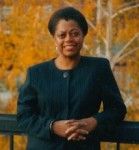
Joann Stevens is program manager of Jazz Appreciation Month (JAM), an initiative to advance appreciation and recognition of jazz as America’s original music, a global cultural treasure. JAM is celebrated in every state in the U.S. and the District of Columbia and some 40 countries every April. Recent posts include Take 5! Where Old Jazz Heads Meet Jazz Novices Over Sweet Notes and Wynton Marsalis, Honoring Duke Ellington.